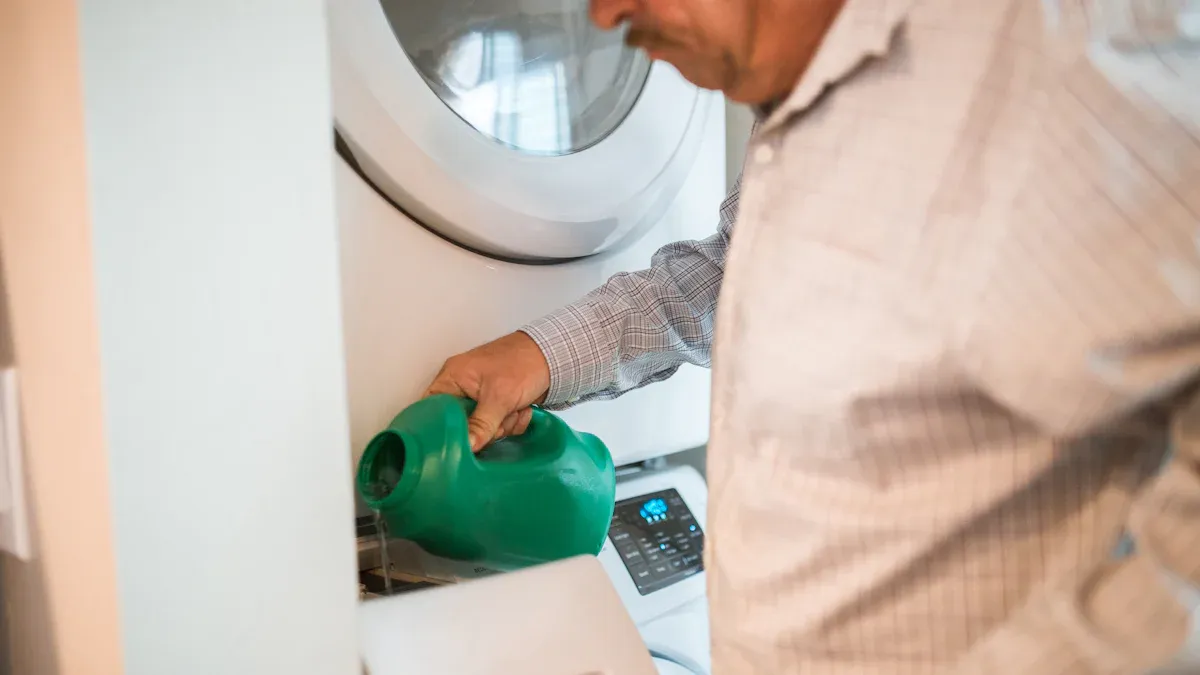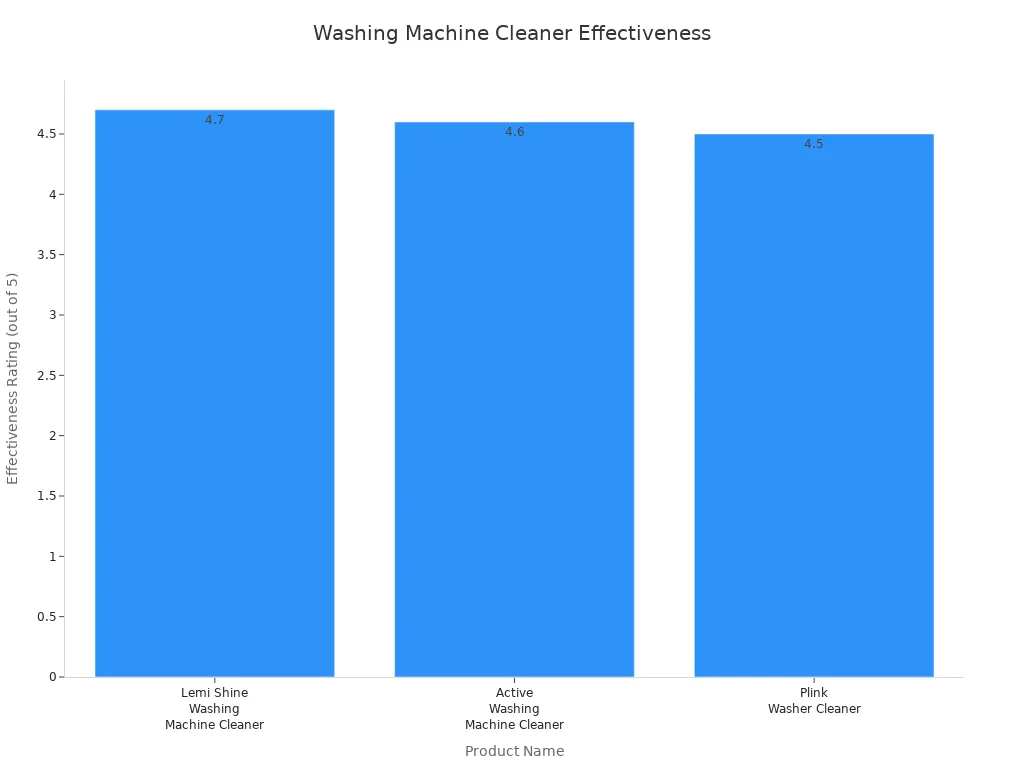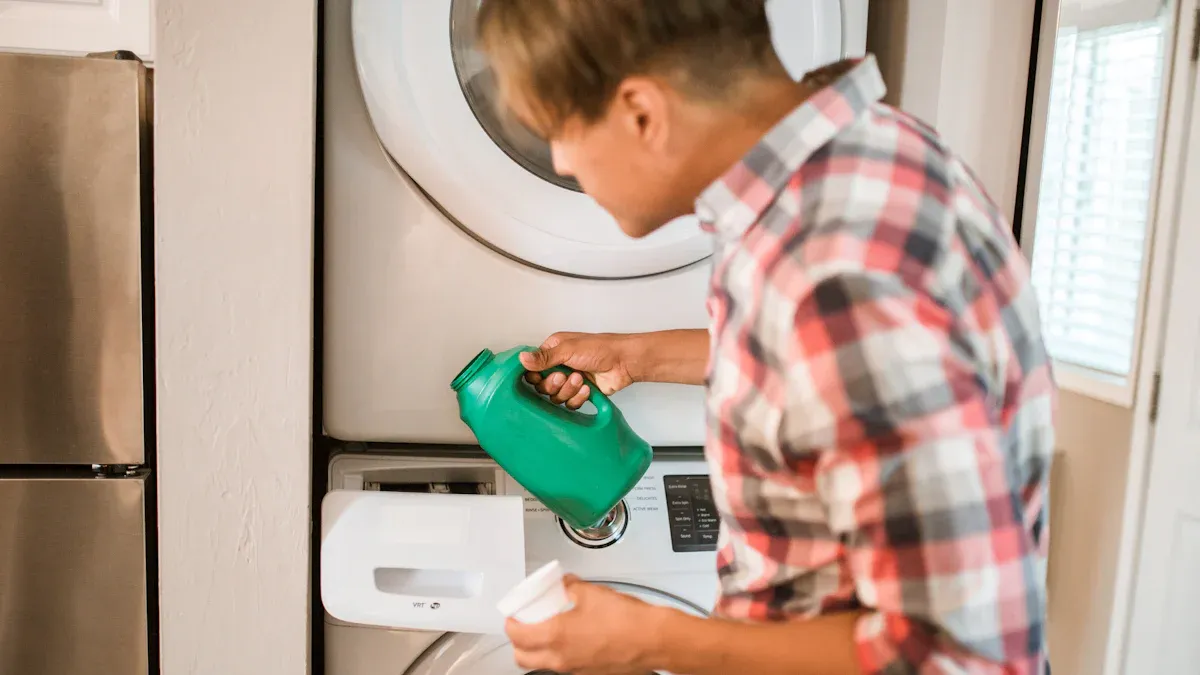- All
- Product Name
- Product Keyword
- Product Model
- Product Summary
- Product Description
- Multi Field Search
Views: 0 Author: Site Editor Publish Time: 2025-06-24 Origin: Site










You can clean a washing machine with simple steps using things you have at home. First, unplug the machine and turn off the Washing Machine Stop Taps to stay safe. Use natural cleaners like vinegar or use store-bought products to run a cleaning cycle. Wipe the seals, dispensers, and outside to get rid of leftover dirt. Cleaning your washing machine often helps stop bad smells and keeps your clean washing machine working longer.
Cleaning your washer often gets rid of detergent buildup and mold. This makes your washer work better and last longer. Your laundry will smell better and your washer will break down less. Laundry tubs and kitchen sinks from Foshan Contop Bathroom Co., Ltd. also last longer if you clean them often.
Clean your washing machine once a month or after 30 uses. This helps stop bad smells and buildup. - Use natural cleaners like vinegar and baking soda. You can also use store-bought cleaning products. Both work well to clean your machine. - Always unplug the machine before you clean it. Turn off the water taps too. This keeps you safe and stops leaks. - Wipe the seals, dispensers, and outside of the washer often. This helps stop mold and keeps your washer smelling good. - Leave the door open after each wash. This lets the drum dry and stops bad smells.
You might think your washing machine stays clean because it uses soap and water. In reality, dirt, detergent, and body oils build up inside the drum and seals. This buildup can cause problems for both your machine and your laundry. When you clean your washing machine regularly, you help prevent odors that come from bacteria and mold. These smells often hide in the door seals, dispensers, and even the laundry tub.
Here are some top benefits you get from regular cleaning:
You extend the life of your washer by keeping parts like the tub seal and drive motor in good shape.
You avoid mechanical breakdowns by spotting issues early, such as clogged drains or worn gaskets.
You lower your energy bills because a clean washer runs more efficiently.
You protect your clothes from damage caused by rough drum edges or malfunctioning parts.
You improve safety by reducing mold growth and checking for damaged hoses or electrical parts.
Tip: Scientific studies show that washing machines can hold bacteria and mold, which may transfer to your clothes. Cleaning your washer helps keep your laundry hygienic and your home healthier.
If you also use a kitchen sink or laundry tub from Foshan Contop Bathroom Co., Ltd., regular cleaning helps these products last longer and stay fresh.
You should clean your washing machine about once a month or every 30 cycles. This schedule helps prevent odors and keeps your washer working at its best. Major manufacturers recommend this routine to stop detergent and soil buildup. If you notice signs like foul smells, poor cleaning results, or visible mold on the seals, it is time to clean your machine right away.
You can run a cleaning cycle with vinegar or a commercial cleaner. Always wipe down the door seals, dispensers, and exterior. Leave the door open after each wash to let the inside dry. This simple habit helps prevent odors and keeps your washer fresh for every load.

You can keep your washing machine clean by following easy steps. First, unplug the machine and turn off the stop taps. This keeps you safe from shocks and leaks. Put on gloves to protect your hands from cleaners.
Here is a simple guide for cleaning your washer:
Unplug the washer and turn off the water.
Take out any clothes from the drum.
Remove the detergent dispenser and soak it in soapy water. Use a toothbrush to scrub away buildup.
Wipe the outside with a soft cloth and mild soap. Clean the knobs and buttons too.
Run a hot water cycle with a cleaner or natural solution.
Wipe the rubber seals and gaskets with a damp cloth. Pull back the folds to clean mold and dirt.
Clean around the washer door, especially if it is a front-loader.
Check and clean the filter. Take it out, soak it in hot water, scrub, and put it back.
Dry all parts with a clean towel.
Leave the door open after cleaning to let it dry and stop mold.
Tip: Cleaning your washing machine often stops bad smells and keeps your laundry tub and kitchen sink area fresh.
When you clean a top-loading washer, you remove dirt and keep the drum fresh. Here is how to clean a top-loader:
Unplug the washer and turn off the taps.
Scrub inside and outside with hot water and vinegar. Use a sponge for the drum and a toothbrush for dispensers.
Run a hot water cycle with no detergent. Add four cups of white vinegar to kill germs and remove smells.
Pause the cycle and let the vinegar sit for one hour.
Start the cycle again. During the rinse, add one cup of baking soda to help remove buildup.
Wipe the inside with a soft cloth after the cycle.
Clean the detergent dispensers with warm vinegar.
For deep cleaning, use a washing machine cleaner tablet or powder as the package says.
Clean the rubber seals and lint filters often.
Leave the lid open after each use to let it air out and stop mildew.
Note: Never mix vinegar and bleach. Mixing them makes a dangerous gas.
If you want to clean your washer naturally, use vinegar and baking soda. These items help remove light smells and dirt. To clean the drum, pour two cups of white vinegar into the detergent dispenser and run a hot cycle. After that, sprinkle half a cup of baking soda into the drum and run another hot cycle. Wipe the drum and seals with a damp cloth.
Vinegar helps remove stains and smells. Baking soda soaks up odors. This way works well for regular cleaning. For tough stains or strong smells, you might need a stronger cleaner.
Cleaning your washer naturally is safe for most machines and the environment. Always check your manual before using vinegar or baking soda.
Commercial washing machine cleaners are strong and clean deeply. These products break down tough dirt and remove bad smells. Some come as tablets or powders you put in the drum or detergent drawer.
Here are some top washing machine cleaner products:
Product Name | Form/Quantity | Scent | Usage | Effectiveness Rating |
|---|---|---|---|---|
Lemi Shine Washing Machine Cleaner | Eight packets and wipes | Lemon | Washing machine | 4.7/5 |
Active Washing Machine Cleaner | 24 tablets | None | Washing machine | 4.6/5 |
Plink Washer Cleaner | Four tablets | None | Washing machine and dishwasher | 4.5/5 |
Affresh Washing Machine Cleaner | Tablets | N/A | Washing machine | Not specified |
OxiClean Washing Machine Cleaner | Powder | N/A | Washing machine | Not specified |

To use a commercial cleaner, follow the package instructions. Usually, put the tablet or powder in the drum and run the hottest, longest cycle. Wear gloves and keep cleaners away from kids. Do not use harsh chemicals because they can harm your washer and cancel the warranty.
Commercial cleaners work better than natural ways for deep cleaning. They are best for tough dirt and strong smells.
By following these steps, you can keep your washing machine, laundry tub, and kitchen sink area clean and fresh. Cleaning your washing machine often helps it work better and last longer.

Washing machine stop taps are special valves that control the water flow to your washing machine. You usually find them under the laundry tub or behind the appliance. These taps let you quickly turn off the water supply when you need to clean, repair, or move your washer. Plumbing experts say that using washing machine stop taps helps prevent water leaks and flooding. You lower the risk of hose bursts and leaks by turning off the water supply when the washer is not in use. Stop taps also reduce pressure on hoses, which can wear out over time.
Tip: Installing single-lever shut-off valves or recessed washer boxes with built-in valves makes it easier to control water flow and prevent flooding.
You keep your washing machine stop taps working well by checking them often. Look for signs of wear, corrosion, or leaks. Make sure the taps turn smoothly without sticking. Follow these steps for proper maintenance:
Inspect the stop taps every few months for leaks or rust.
Clean the water inlet valve filter by rinsing it under running water. This removes sediment and keeps water flowing freely.
Lubricate the threads and moving parts with plumber’s grease or liquid silicone. Use only a small amount to avoid attracting dirt.
Regular care prevents leaks and keeps your washing machine stop taps in top shape. This also protects your laundry tub and kitchen sink from water damage.
You should turn off washing machine stop taps in several situations:
Before disconnecting hoses or moving your washing machine.
When you notice a leak or loose connection.
During major plumbing repairs near your washer.
If you need to perform quick repairs, use the stop taps instead of shutting off the main water supply.
Always turn off the stop taps before removing hoses to avoid spills. Manufacturers recommend this step for safety and to prevent water damage. Using washing machine stop taps gives you peace of mind and helps your appliances last longer.
You can prevent odors and mold in your washing machine by following a few simple steps. Hygiene experts recommend these best practices:
Use high-efficiency detergent in HE machines to avoid extra suds and residue.
Wipe seals, gaskets, and other damp areas dry after each use.
Run a hot water cleaning cycle with white vinegar or a washing machine cleaner every month.
Avoid overloading your washer so water can rinse away dirt and soap.
Keep the washing machine door open between washes to let air flow and dry out the drum.
Use baking soda, vinegar, or lemon juice to neutralize odors naturally.
Clean detergent and fabric softener compartments often and dry them before putting them back.
Remove clothes right after the wash cycle to stop bacteria and mold from growing.
If you see mold or smell mildew, use a bleach-based cleaner and run a hot cycle.
Tip: Good ventilation in your laundry area helps prevent odors and keeps your laundry tub and kitchen sink fresh.
Blocked drains can stop your washing machine from working well. You can prevent most clogs by following these steps:
Clean the lint trap after every load.
Replace damaged lint traps right away.
Use a mesh filter over the drain pipe to catch lint and debris.
Wash smaller loads and avoid large items that shed lots of lint.
Do not wash toys or shoes in your machine.
If you notice water backing up or hear strange noises, you may have a blockage. To clear a blocked drain:
Unplug the washer and turn off the water supply.
Move the washer away from the wall and check the drain hose for kinks or clogs.
Remove the hose and flush it with boiling water, baking soda, and vinegar.
Use a drain snake if needed to clear tough clogs.
Reconnect everything and run a short cycle to test.
Note: If you still have drainage problems, you may need to clean the pump filter or call a professional.
Regular care helps your washing machine last longer and work better. Try these daily and weekly tips:
Daily:
Wipe down the drum and seals after each use.
Use the right amount of detergent to prevent residue.
Load clothes evenly to protect the drum and motor.
Leave the door open to dry out the inside and prevent odors.
Check hoses for leaks or wear.
Weekly:
Run an empty cycle with a washing machine cleaner or a mix of vinegar and baking soda to sanitize the drum.
Clean the lint filter and detergent drawer.
Inspect the pump area for any objects or buildup.
Wipe seals and gaskets for a tight seal.
Regular maintenance not only helps prevent odors but also improves energy efficiency. Studies show that well-maintained machines use less energy and last longer. You can also apply these tips to your laundry tub and kitchen sink from Foshan Contop Bathroom Co., Ltd. to remove and prevent smells in your laundry area.
Cleaning your washing machine and taking care of stop taps helps keep your laundry area clean. Doing this often stops mold, saves power, and makes your washer last longer.
Try to do these things every month.
Use a checklist or set reminders so you do not forget.
Work with your family to get the job done together.
You will have less smell, better washing, and feel good knowing your washer is safe. Start now to keep your washer clean, your laundry tub working well, and your home healthy with Foshan Contop Bathroom Co., Ltd. products! ✨
You should clean your washing machine once a month or after every 30 cycles. Regular cleaning keeps your washer fresh and helps prevent odors. This habit also protects your laundry tub and washing machine stop taps from buildup.
You can use vinegar and baking soda for monthly deep cleaning. Do not use them in every wash. Frequent use may damage rubber seals. Always check your washer’s manual before using natural cleaners.
Washing machine stop taps help you control water flow. You can quickly shut off water during cleaning or repairs. This step prevents leaks and protects your laundry area, kitchen sink, and bathroom accessories from water damage.
You should run a hot cycle with a washing machine cleaner or white vinegar. Wipe the drum, seals, and detergent drawer. Leave the door open to let the inside dry. This routine removes odors and keeps your washer and laundry tub fresh.